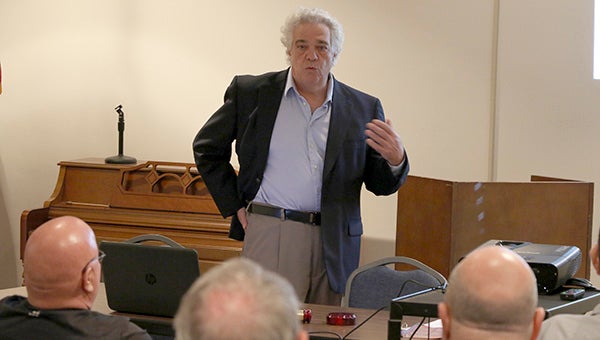Former employee shares history of Stennis buffer zone
Published 7:00 am Thursday, September 15, 2016

HISTORY LESSON: Marco Giardino speaks to members of the Pearl River County Historical Society during their meeting on Wednesday. His presentation covered the history of Stennis Space Center as outlined in his research that lasted more than 20 years.
Photo by Jeremy Pittari
It’s often been said that if someone wants to get to space, they have to go through Hancock County.
That’s because the nation’s largest rocket engine testing facility is located within a buffer zone within that county.
But centuries before mankind made that trek to the moon, people were creating a very interesting history within that area.
Marco Girdino has a doctorate in archeology, and also worked at Stennis Space Center. During his time there he was tasked with using remote sensing technology to find and research important archeological sites within the buffer zone from the 1990s until 2010.
What they found at the site was not just the remnants of old towns relocated in the 1960s to make way for rocket engine testing, but artifacts dating back to before Christ. He said they found Native Indian ceramics dating back to about 500 BC, and a place called Poverty Point, a large mound that dated back to almost 1500 BC and appeared to have served as a ceremonial center.
His research also showed that the Favre name is now so prevalent because one of the family’s ancestors was not very picky, choosing wives of various races and backgrounds.
As most locals know, the development of the buffer zone meant that residents within several towns had to be relocated, including Napoleon, Log Town, Gainesville and Santa Rosa. He said Gainesville used to be the county seat.
He also confirmed the legend of the woman who sat on her porch while her house was being moved. Her name was Aunt Blue, and she was so opposed to having to relocate, she sat upon a rocking chair on the porch of her home while it was moved from its original site.
In between the years of 1961 and 1974, 3,100 land parcels were negotiated by the Corps of Engineers to secure the land that would make up the buffer zone. To accomplish that, many of the deeds were purchased outright, while some were acquired through private easement, meaning the owner still had rights to the land, but could develop it. Back then, the purchase price of land was published in the local paper, so, if someone being offered $13,000 for a piece of land saw that another person received $30,000, “that caused squawking,” Girdino said.
Girdino also told the tale of how the Pearl River earned its name. The story goes that settlers to the area saw Native Americans harvesting pearls of low quality from the river, leading to the moniker.
His research into past deeds found one dating back to 1733.
“Deeds this old are hard to find because courthouses have this annoying habit of burning down,” Girdino said.
Girdino also covered the largest names to “discover” or claim ownership of the site, and the fact that it has been occupied by Native Americans, French, Spanish and then eventually sold to the United States.
While this story covered only a portion of Girdino’s presentation, he said there is a 200-page book filled will all the facts discovered during their research. To gain access to it, interested parties should call the Stennis public relations office.


